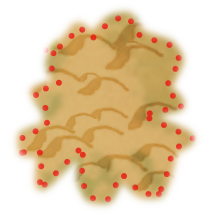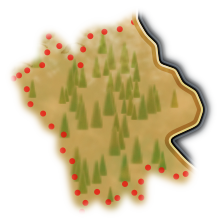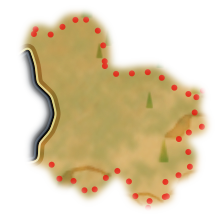Terrain Effects
We have recently added terrain effects to the game, so mountains, forests and plains are no longer just cosmetic. Having these additional variables coming out of the map generation process makes each map feel more distinctive. As well as the connectivity of the regions, you now need to consider the terrain in each region when developing your strategy.
 Mountains are difficult to move into, requiring two action points per soldier instead of one. This makes them good places to defend if you can get your soldiers in position before the enemy arrives, as it is very expensive for your opponent to attack with a large number of soldiers. Mountains also tend to channel armies into natural corridors when moving across the map, so you can gain a strategic advantage by identifying and controlling bottlenecks in those corridors.
Mountains are difficult to move into, requiring two action points per soldier instead of one. This makes them good places to defend if you can get your soldiers in position before the enemy arrives, as it is very expensive for your opponent to attack with a large number of soldiers. Mountains also tend to channel armies into natural corridors when moving across the map, so you can gain a strategic advantage by identifying and controlling bottlenecks in those corridors.
 Forests allow solitary soldiers defending them to perform a fighting retreat when attacked by a larger force. This means they inflict a single casualty on the attacking army and then retreat to a neighbouring region. These guerrilla tactics penalise large armies, making forests good places to hide if you’re outnumbered, putting a brake on players with a military advantage. The idea is that large armies struggle to manoeuvre when restricted by the confines of a forest, while small units can ambush a superior force and retreat.
Forests allow solitary soldiers defending them to perform a fighting retreat when attacked by a larger force. This means they inflict a single casualty on the attacking army and then retreat to a neighbouring region. These guerrilla tactics penalise large armies, making forests good places to hide if you’re outnumbered, putting a brake on players with a military advantage. The idea is that large armies struggle to manoeuvre when restricted by the confines of a forest, while small units can ambush a superior force and retreat.
 Plains have no direct effect on movement or combat, but some plains regions provide supply. We will describe the supply mechanic in more detail in a later post, but the important thing is that you need supply if you want to assemble a large army. The fact that only plains regions can provide supply creates an interesting tension between defending supply regions and sticking to more defensible terrain.
Plains have no direct effect on movement or combat, but some plains regions provide supply. We will describe the supply mechanic in more detail in a later post, but the important thing is that you need supply if you want to assemble a large army. The fact that only plains regions can provide supply creates an interesting tension between defending supply regions and sticking to more defensible terrain.
